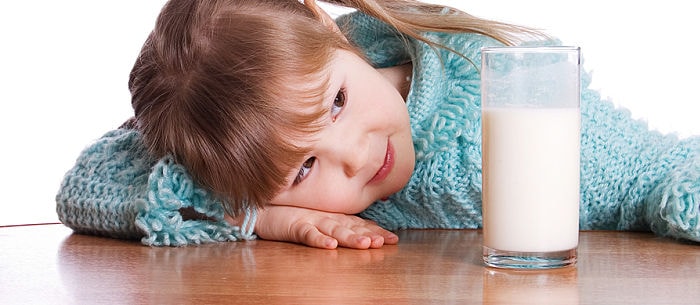Pizza, ice cream, grilled cheese — lots of kids’ favorite foods contain dairy. But what do you do if your little one suddenly gets a tummy ache every time she indulges in a little cheese or cream? Even if she was born with the ability to digest milk, depending on your child’s genetic code, she may naturally become lactose intolerant sometime after age 2. Here’s how to tell if you’re dealing with lactose intolerance in children, and what you can do to help.
What Is Lactose Intolerance?
Lactose intolerance is not the same as a milk allergy. “Lactose intolerance is the body not having enough of the lactase enzyme, which breaks down the lactose,” says Dr. Matthew Brennecke, a board-certified naturopathic doctor in Colorado. “If lactose makes it to the colon, it starts to ferment, causing gas and osmotic imbalances, leading to diarrhea.”
On the other hand, a dairy allergy is a true food allergy caused by an immune response to the milk proteins. Dr. Brennecke says, “Milk allergies are some of the most common forms of food allergies out there, especially in very young children.”
At some point after infancy, about 75 percent of the world’s population stops producing lactase, the enzyme required to digest lactose. “Fortunately, children with lactose intolerance will be able to tell you that they are having abdominal pain,” says Dr. Brennecke. Symptoms will generally begin within 30 minutes to 2 hours after eating, and usually include abdominal distention, abdominal pain, gas, bloating and diarrhea.
Getting a Diagnosis
“If you are not sure what food could be affecting your child, I love using a food diary with my clients,” says Deborah Malkoff-Cohen, a registered dietitian at City Kids Nutrition, and the pediatric nutrition co-chair for the Greater New York Dietetic Association. She gives parents a chart with the following columns: time of meal, food eaten, type of gastrointestinal discomfort (if any), stool consistency/smell and notable behavior issues. “We then analyze the chart and narrow down what may be causing the discomfort,” she says.
You can also talk to your child’s health care provider about getting a formal diagnosis. One common test for lactose intolerance is the hydrogen breath test, which Brennecke says is easy, inexpensive, non-invasive, and accurate. “You basically fast overnight, ingest 25 grams of lactose, then breathe into a bag at one-, two- and three-hour intervals.” If your child is lactose intolerant, the test will show a high level of hydrogen and methane in the breath. (There are also stool and blood tests available.)
How Can You Help?
Luckily, lactose intolerance in children can be controlled through diet. What children can eat depends on the level of the enzyme their bodies produce — some kids can tolerate some dairy, while others need to avoid it completely. “Kids with lactose intolerance may find that certain dairy products, such as yogurt and aged cheese — like cheddar, Parmesan and Swiss — have less tummy side effects as they contain the lactase enzyme,” says Malkoff-Cohen. Eating dairy with other foods may also help reduce side effects.
In addition, there’s help out there for occasional diet cheats. “A lactase enzyme supplement can also be used before eating an offensive food, like if your child cannot resist pizza and ice cream at a birthday party,” suggests Malkoff-Cohen, adding, “Lactose-free milk is an option and is great way to get calcium in your child’s diet without the stomach issues.” In addition, many non-dairy milks — soy, almond, coconut, rice and others — are widely available in supermarkets. (However, kids who drink non-cow’s milk can be twice as likely to have low vitamin D, so talk to your children’s pediatrician if you have concerns about that.)
Read Those Food Labels
When grocery shopping, remember that terms like “dairy-free” and “non-dairy” don’t have exact meanings, and those products may have ingredients derived from milk. Generally, Kosher foods labeled pareve or parve will almost always be milk-free.
“Teach your child to read ingredient lists for all packaged foods,” Malkoff-Cohen says. Because of the Food Allergen Labeling and Consumer Protection Act (FALCPA), the top eight allergens — including milk — have to be clearly listed underneath product ingredients.
You Can Do This!
If this sounds like a lot to handle, take heart: your child or the child you care for will also learn early on how much good nutrition matters. Once you both know the drill, dealing with lactose intolerance in children will be second nature.
And try these 5 Milk Alternatives Your Kids Will Enjoy.
Nancy J Price is an Arizona-based mother of four, as well as a writer, editor and web developer. One of the original co-founders of SheKnows.com, she now writes for several websites, including Myria and Click Americana.
* This article is for general informational purposes only. It is not intended nor implied to be providing medical advice and is not a substitute for such advice. The reader should always consult a health care provider concerning any medical condition or treatment plan. Neither Care.com nor the author assumes any responsibility or liability with respect to use of any information contained herein.




